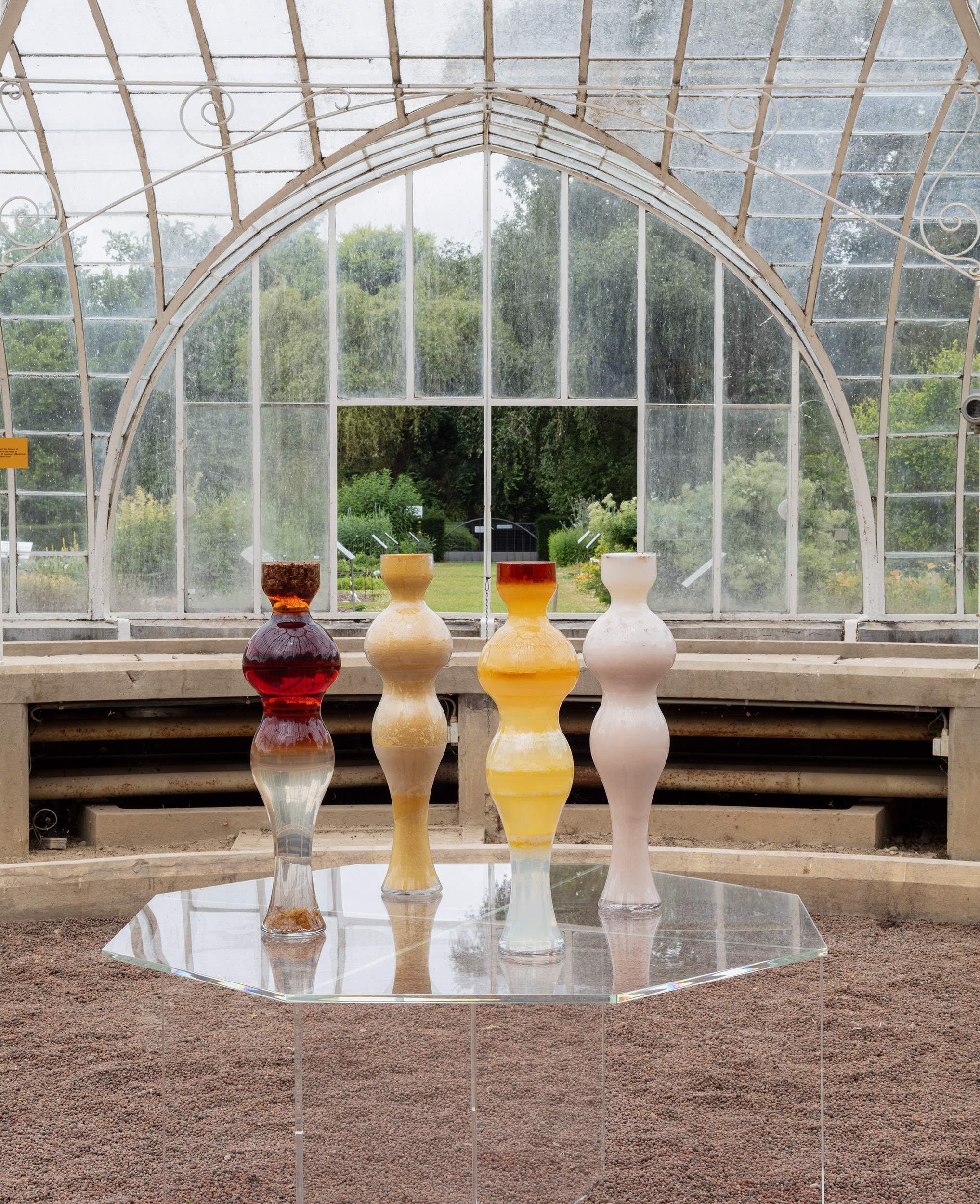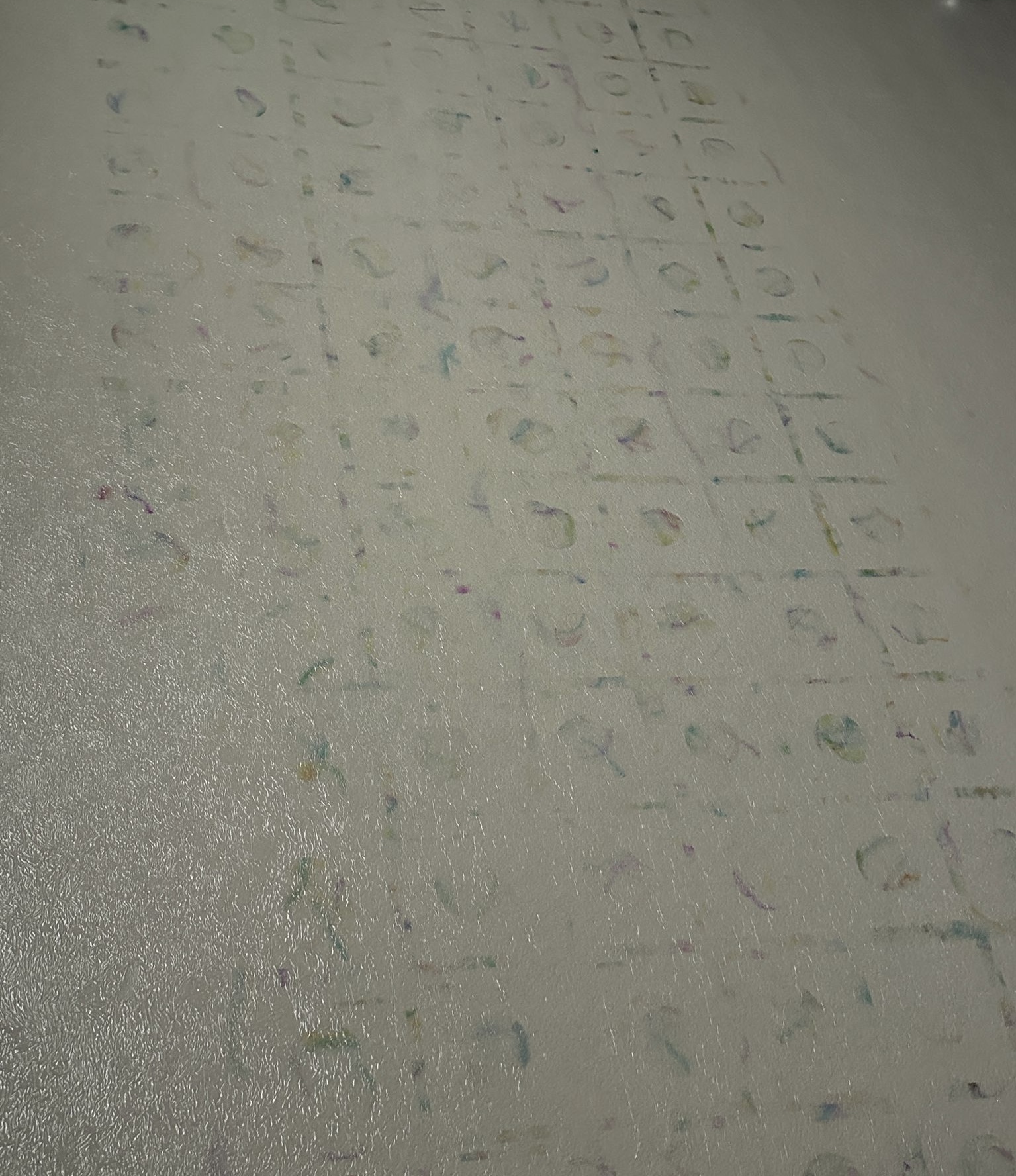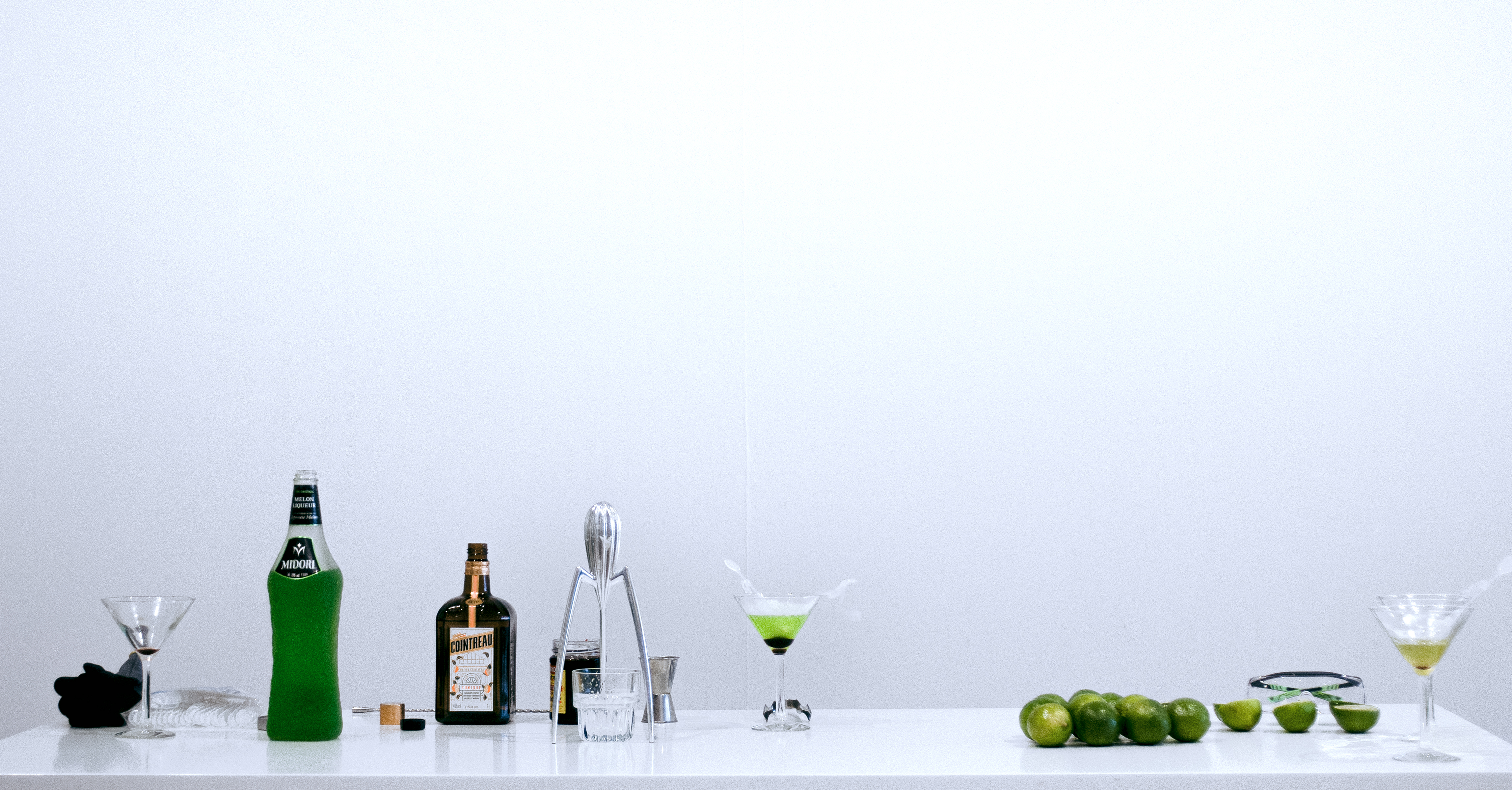MYRTHE VAN DER MARK
the Netherlands, 22.12.1989
currently based in Brussels

Sein Vater ist die Sonne, und seine Mutter ist der Mond. Der Wind trug es in seinem Bauche, und seine Amme ist die Erde, 2025
Series of four St. John’s Wort preparations, vase in glass by Serax found at Rotor Deconstruction
her phone reading: the moon in June falls mainly on the spoon, 2025
WALA Solum Öl, Hermès Terre d’Hermès
not for ourselves alone, 2025
Audio, recordings of St. John's songs sung by children from the Steiner School in Brussels (Sint-Janskruidlaan) are played through speakers
Presented at Publiek Park 2025
Plantentuin Meise (BE)
Series of four St. John’s Wort preparations, vase in glass by Serax found at Rotor Deconstruction
her phone reading: the moon in June falls mainly on the spoon, 2025
WALA Solum Öl, Hermès Terre d’Hermès
not for ourselves alone, 2025
Audio, recordings of St. John's songs sung by children from the Steiner School in Brussels (Sint-Janskruidlaan) are played through speakers
Presented at Publiek Park 2025
Plantentuin Meise (BE)








Myrthe van der Mark’s installation unfolds within the historic Victoria Greenhouse, or Balatkas – one of the most emblematic structures of the Meise Botanic Garden. Designed in 1854 by Alphonse Balat, court architect to Leopold II, the ornate octagonal glasshouse was originally built for the Brussels zoo. In 1878, it was relocated to the Jardin Botanique to cultivate Victoria amazonica, the giant tropical water lily sustained by a heated basin. Since 1941, the greenhouse has stood in Meise as a testament to nineteenth-century botanical architecture.
Myrthe van der Mark’s installation draws on hermetic traditions and the anthroposophic teachings of Rudolf Steiner – principles she was raised with as a child. Publiek Park opens during a symbolic moment: the birthday of her late father and the week of Saint John’s Eve, a solstice celebration associated with purification and transition. Marking both the birth and name day of John the Baptist, it is a time when light and warmth reaches its peak on one of the longest days of the year.
An octagonal plexiglass platform, mirroring the dimensions of the crown window above, presents four preparations of Saint John’s Wort, a healing plant that thrives in the medicinal garden beside the Balatkas. Salve, soap, infusion, and watercolour – distilled by the artist from her own harvest – are contained in anthropomorphic vases, prepared with beeswax and honey from the Plantentuin’s beekeeper. These four vessels serve as evocations of the installation’s title. Its father is the Sun, its mother the Moon. The Wind carried it in its belly, its nurse is the Earth is a central passage from the Tabula Smaragdina, a foundational alchemical text attributed to Hermes Trismegistus which deeply influenced Steiner’s cosmology. In the medieval garden of the Plantentuin, Van der Mark planted eight Saint John’s Wort plants in an octagonal formation, encircling four myrtle shrubs at the center as an echo to this installation.
Saint John’s Eve, central in Steiner education, is a festive gathering of music, bonfires, and flower wreaths, marking the school year’s end. For this work, the artist collaborated with the children from the Steiner school in Brussels, aptly located on Saint John’s Wort Street, to sing solstice songs in multiple languages. Their recording, Non nobis solum (“not for ourselves alone”), performed at the exhibition opening, now resonates continuously within the greenhouse as the days begin to shorten.
The windows are embalmed with Solum oil, used by the artist to anoint her father’s feet in his final days, and scented with Terre d’Hermès (Earth of Hermes). The Latin word "solum" means soil, but also translates to alone and sole. In botanical terms, it refers to the vital layer of earth that supports life. Solum oil is produced by the German company WALA. Deeply influenced by the teachings of Rudolf Steiner, its name stands for Wärme (Warmth), Asche (Ash), Licht (Light), and again Asche-a cyclical sequence evoking transformation. The perfume’s name alludes to Hermes, the Greek god of commerce and communication, who is also a figure of transition, as he moves freely between worlds. More than a messenger, he guides souls to the underworld. This crossing of thresholds – between child and parent, day and night, life and death, matter and soul – echoes through the work’s gestures of sound, scent, and presence.
Myrthe van der Mark’s installation draws on hermetic traditions and the anthroposophic teachings of Rudolf Steiner – principles she was raised with as a child. Publiek Park opens during a symbolic moment: the birthday of her late father and the week of Saint John’s Eve, a solstice celebration associated with purification and transition. Marking both the birth and name day of John the Baptist, it is a time when light and warmth reaches its peak on one of the longest days of the year.
An octagonal plexiglass platform, mirroring the dimensions of the crown window above, presents four preparations of Saint John’s Wort, a healing plant that thrives in the medicinal garden beside the Balatkas. Salve, soap, infusion, and watercolour – distilled by the artist from her own harvest – are contained in anthropomorphic vases, prepared with beeswax and honey from the Plantentuin’s beekeeper. These four vessels serve as evocations of the installation’s title. Its father is the Sun, its mother the Moon. The Wind carried it in its belly, its nurse is the Earth is a central passage from the Tabula Smaragdina, a foundational alchemical text attributed to Hermes Trismegistus which deeply influenced Steiner’s cosmology. In the medieval garden of the Plantentuin, Van der Mark planted eight Saint John’s Wort plants in an octagonal formation, encircling four myrtle shrubs at the center as an echo to this installation.
Saint John’s Eve, central in Steiner education, is a festive gathering of music, bonfires, and flower wreaths, marking the school year’s end. For this work, the artist collaborated with the children from the Steiner school in Brussels, aptly located on Saint John’s Wort Street, to sing solstice songs in multiple languages. Their recording, Non nobis solum (“not for ourselves alone”), performed at the exhibition opening, now resonates continuously within the greenhouse as the days begin to shorten.
The windows are embalmed with Solum oil, used by the artist to anoint her father’s feet in his final days, and scented with Terre d’Hermès (Earth of Hermes). The Latin word "solum" means soil, but also translates to alone and sole. In botanical terms, it refers to the vital layer of earth that supports life. Solum oil is produced by the German company WALA. Deeply influenced by the teachings of Rudolf Steiner, its name stands for Wärme (Warmth), Asche (Ash), Licht (Light), and again Asche-a cyclical sequence evoking transformation. The perfume’s name alludes to Hermes, the Greek god of commerce and communication, who is also a figure of transition, as he moves freely between worlds. More than a messenger, he guides souls to the underworld. This crossing of thresholds – between child and parent, day and night, life and death, matter and soul – echoes through the work’s gestures of sound, scent, and presence.

HARVESTING BULBS. GROWTH OF THE SOIL. JUST BE WATER, MY FRIEND. [PENSIVE ORCHESTRAL MUSIC PLAYING]
2025, pile of Flexi disc edition SPACE AGE CRYSTALS, glass, plinth, lighting, carpet
For the IKOB – Feminist Art Prize, the artist presents a performance at the exhibition opening: It, it is usual to add rose which is four rows. It is usual to add it. (2024–25). Taking place in the museum’s storage room, which is usually closed to visitors, the performance explores the symbolism of braids, the colors of mourning and its accompanying scents, flower arrangements, architectural clothing, accessories, tableware, and small, elaborate hair works. A landscape, a portrait, a still life. It, it is usual to add rose which is four rows. It is usual to add it. was commissioned by de Brakke Grond, Amsterdam, and is a collaboration with the musician Joachim Badenhorst.
In the exhibition, van der Mark presents a sculptural element titled Harvesting bulbs. Growth of the soil. Just be water, my friend. [pensive orchestral music playing] (2025). It contains a stack of her Flexi disc edition SPACE AGE CRYSTALS (2022). The Flexi disc is a phonograph record made of a thin, flexible vinyl sheet and deteriorates when played for an extended time. The Flexis on display at IKOB contain recordings of van der Mark’s father’s last days, reworked into music by Joachim Badenhorst.
During her performance, van der Mark used airbrush blow pens to paint on envelopes that act as sleeves for the edition. These are available to purchase in the bookshop, each accompanied by one Flexi disc presented in the exhibition.
Price: €15
©️ IKOB - Museum für Zeitgenössische Kunst, Credits: Lola Pertsowsky
Presented at IKOB - Museum of Contemporary Art, Eupen (BE)
2025, pile of Flexi disc edition SPACE AGE CRYSTALS, glass, plinth, lighting, carpet
For the IKOB – Feminist Art Prize, the artist presents a performance at the exhibition opening: It, it is usual to add rose which is four rows. It is usual to add it. (2024–25). Taking place in the museum’s storage room, which is usually closed to visitors, the performance explores the symbolism of braids, the colors of mourning and its accompanying scents, flower arrangements, architectural clothing, accessories, tableware, and small, elaborate hair works. A landscape, a portrait, a still life. It, it is usual to add rose which is four rows. It is usual to add it. was commissioned by de Brakke Grond, Amsterdam, and is a collaboration with the musician Joachim Badenhorst.
In the exhibition, van der Mark presents a sculptural element titled Harvesting bulbs. Growth of the soil. Just be water, my friend. [pensive orchestral music playing] (2025). It contains a stack of her Flexi disc edition SPACE AGE CRYSTALS (2022). The Flexi disc is a phonograph record made of a thin, flexible vinyl sheet and deteriorates when played for an extended time. The Flexis on display at IKOB contain recordings of van der Mark’s father’s last days, reworked into music by Joachim Badenhorst.
During her performance, van der Mark used airbrush blow pens to paint on envelopes that act as sleeves for the edition. These are available to purchase in the bookshop, each accompanied by one Flexi disc presented in the exhibition.
Price: €15
©️ IKOB - Museum für Zeitgenössische Kunst, Credits: Lola Pertsowsky
Presented at IKOB - Museum of Contemporary Art, Eupen (BE)

YEAH, BUT WHO? I MIGHT KNOW HER.
2024, performance, Japanese Slipper; Cocktail Glass, Midori, Cointreau, Lime Juice, Maraschino Cherry, Dry Ice, Misty Stix, variable dimensions; open edition
Work can take many different forms, as varied as the environments, tools, skills, goals, and institutions around a worker. For De Langste Dag van der Mark will view ‘a workplace’ as human activity contributing towards the goods and services. This refers to a general activity of performing tasks, whether they are paid or unpaid, formal or informal. It encompasses any effort or activity directed towards achieving a particular goal. She approaches serving staff as an example of a common profession, attending to customers by supplying them with a cocktail as requested: Japanese Slipper. The passage of time is represented by the sublimation process of dry ice, incorporated into the cocktail. Here, the word sublimation is used to describe an exchange of "bodies" and "spirits" similar to laboratory phase transition between solids and gases.
Price: €7.40
Presented at Mu.ZEE & KAAP
Ostend (BE)
2024, performance, Japanese Slipper; Cocktail Glass, Midori, Cointreau, Lime Juice, Maraschino Cherry, Dry Ice, Misty Stix, variable dimensions; open edition
Work can take many different forms, as varied as the environments, tools, skills, goals, and institutions around a worker. For De Langste Dag van der Mark will view ‘a workplace’ as human activity contributing towards the goods and services. This refers to a general activity of performing tasks, whether they are paid or unpaid, formal or informal. It encompasses any effort or activity directed towards achieving a particular goal. She approaches serving staff as an example of a common profession, attending to customers by supplying them with a cocktail as requested: Japanese Slipper. The passage of time is represented by the sublimation process of dry ice, incorporated into the cocktail. Here, the word sublimation is used to describe an exchange of "bodies" and "spirits" similar to laboratory phase transition between solids and gases.
Price: €7.40
Presented at Mu.ZEE & KAAP
Ostend (BE)

AIRDROP
2024, performance
UbuWeb is a web-based educational resource for avant-garde material operating on the basis of a gift economy. AirDrop derived from a selection of videos from the Dance section of UbuWeb in collaboration with artist Louise Delanghe. The setting of this bootleg series is a needle punch mandarin carpet, created through van der Mark’s installation Girl lives in the village. Sculptress. If you must know., at CC Strombeek. The carpet bears the traces from 29 skylight domes imprinted through LED light into the orange carpet over time. Delanghe indicates the rhythm of the choreography, and the registration of the work was transmitted through AirDrop by the curator of the exhibition.
Presented at Avee Gallery
Kortrijk (BE)
2024, performance
UbuWeb is a web-based educational resource for avant-garde material operating on the basis of a gift economy. AirDrop derived from a selection of videos from the Dance section of UbuWeb in collaboration with artist Louise Delanghe. The setting of this bootleg series is a needle punch mandarin carpet, created through van der Mark’s installation Girl lives in the village. Sculptress. If you must know., at CC Strombeek. The carpet bears the traces from 29 skylight domes imprinted through LED light into the orange carpet over time. Delanghe indicates the rhythm of the choreography, and the registration of the work was transmitted through AirDrop by the curator of the exhibition.
Presented at Avee Gallery
Kortrijk (BE)